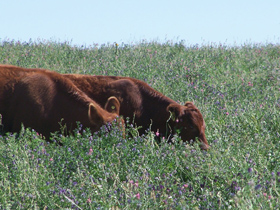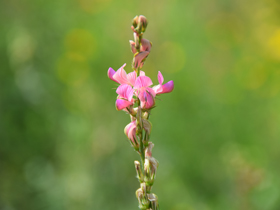Persistence Pays
This article written by Dr. Reynold Bergen, BCRC Science Director, originally appeared in the May 2019 issue of Canadian Cattlemen magazine and is reprinted on the BCRC Blog with permission of the publisher.

Forage legumes provide high yields, protein, and good animal performance while improving soil fertility by fixing nitrogen from the air. Alfalfa is the highest yielding and most widely-used legume but can cause bloat. Legumes like cicer milkvetch, sainfoin and birdsfoot trefoil do not cause bloat. As little as 25% sainfoin in a pasture can virtually eliminate the risk of bloat even if the other 75% is alfalfa.
The problem is that older sainfoin varieties don’t regrow as fast as alfalfa after grazing. Alfalfa’s aggressive nature allows it to outcompete sainfoin for sunlight, moisture and nutrients. Without careful grazing management, sainfoin can disappear from a pasture in a few years. This might be because plant breeders have traditionally selected new varieties for clipped forage yield under monoculture conditions. This doesn’t reflect the challenges sainfoin faces when grown with alfalfa and grazed.
Surya Acharya at AAFC Lethbridge has been breeding sainfoin that regrows more rapidly after grazing and persists longer in mixtures with alfalfa. New varieties (e.g. Mountainview and Glenview) have already been released, but there are more in the pipeline. An update on these ongoing efforts was published in 2017 (Performance of Mixed Alfalfa-Sainfoin Pastures and Grazing Steers in Western Canada, Professional Animal Scientist 33:472).
What They Did:
New sainfoin populations were selected at AAFC Lethbridge for improved regrowth and persistence when grown with alfalfa and cut several times during the growing season. Three promising sainfoins (coded as A, B and C, with Nova as a control) were seeded with alfalfa in alternate rows to achieve 50:50 alfalfa:sainfoin stands, and tested under grazing conditions in Swift Current and Lethbridge. In Swift Current, sainfoin was seeded with Beaver alfalfa in 2009 and rotationally grazed under dryland conditions using 80 yearling Angus steers in 2010 and 2011. In Lethbridge, sainfoin was seeded with AC Blue J alfalfa (which yields better than Beaver) in 2008, cut in 2009, and rotationally grazed under irrigation using 80 yearling Hereford steers in 2010, 2011 and 2012. Pastures were rotated when 60% of the forage had been used. Alfasure was used for bloat control in Lethbridge but not Swift Current. Forage yields, persistence, animal performance and bloat were tracked.

What they Learned:
All growing seasons were wetter than the 30-year average at both locations, but irrigation allowed longer rotational grazing seasons in Lethbridge (41 to 61 days) than in Swift Current (21 to 29 days).
Forage yields averaged 1.8 tons/acre and did not differ among any of the alfalfa:sainfoin mixtures in either grazing season at Swift Current. At Lethbridge, rotationally grazed pastures averaged 4.1 tons/acre. Sainfoin A out-yielded Nova in one year, C out-yielded Nova in two years, and B out-yielded Nova in all three rotational grazing seasons.
Sainfoin persistence: All plots contained 50% sainfoin at the start. By year 2 in Swift Current, sainfoin B was 39% of the stand, while A, C and Nova had dropped to 25 or 26%. After three years of rotational grazing in Lethbridge, B was at 40%, C was intermediate (29%), while A and Nova were lowest (5 to 11%).
Animal performance: Average daily gains and gains per acre were higher in Lethbridge (2.3 lbs/day and 397 lbs/acre) than in Swift Current (2.1 bs /day and 187 lbs/acre) but not statistically different among varieties at either location. More animal data would be needed to detect performance differences among the sainfoin. No bloat was observed.
What it Means:
Upcoming sainfoin varieties have improved persistence and yield when grown and grazed in mixed stands with alfalfa, but one size doesn’t fit all. The varieties that perform best in slightly heavier soil and irrigation may not perform as well under drier, more challenging conditions.
This team used an unusual approach. Not all forage breeders test new strains under different soil, climatic and management conditions before releasing varieties. That’s important, because new forage species or varieties may not meet expectations if they were developed under conditions that don’t resemble your own. Ask questions when considering new varieties – results may vary!
Long-term forage breeding work is costly, especially when multiple sites are used. Grazing trials are even costlier; more seed is needed for each of the experimental varieties in order to establish plots that are large enough to graze, plus the added land, animal, sampling and analysis costs. Producer check-off investments are important to make sure that AAFC and other public institutions maintain their forage breeding programs. This is especially critical for legumes like sainfoin; their smaller acreage relative to alfalfa may not attract investment from private breeders.
The Productivity pillar of Canada’s National Beef Strategy aims to increase production efficiencies by 15%, partly by increasing the yields and nutritional quality of tame and native annual and perennial forages through improved pasture, hay and grazing management, plant breeding and variety selection recommendations. The Strategy explains why the Canadian Beef Cattle Check-Off increased from $1 to $2.50 per head in most provinces (with approximately 75 cents allocated to the Beef Cattle Research Council), and how it is being invested.
The Beef Research Cluster is funded by the Canadian Beef Cattle Check-Off and Agriculture and Agri-Food Canada with additional contributions from provincial beef industry groups and governments to advance research and technology transfer supporting the Canadian beef industry’s vision to be recognized as a preferred supplier of healthy, high quality beef, cattle and genetics.
Click here to subscribe to the BCRC Blog and receive email notifications when new content is posted.
The sharing or reprinting of BCRC Blog articles is typically welcome and encouraged, however this article requires permission of the original publisher.